OCTOBER—FOND MEMORIES, THE HUNTER’S MOON, AND MORE
SUFFERING IN MY HIGHLAND HOMELAND
As anyone who has paid attention to this newsletter over the years is aware, I’m a son of the North Carolina Smokies whose heart will always belong to my highland homeland. While my home county of Swain suffered comparatively little damage from Hurricane Helene, mainly in the form of flooding, obviously the same was not true of the wider area. I have a lady friend who is a resident of Arden, a small community just outside of Asheville. Her lovely home suffered tremendous damage, yet as she pointedly has reminded me, mountain folks are tough and “I’m all right physically and my losses are just material ones. Other families have lost loved ones or everything they had.”
If you are financially able, I would encourage you to donate as you can, while readily recognizing that in all likelihood many of you have likely already done exactly that. Hardy mountain folks are historically reluctant to take any type of handout, but in this situation they desperately need a hand up. They are helping one another in a fashion that harkens back to the independence of yesteryear, but the magnitude of damage is such that local interaction isn’t enough.
I’ve got enough local contacts to feel confident in saying that government sources on the national level, particularly FEMA, are either missing in action or clueless. Obviously it is each individual’s call, but if you are inclined to donate I will mention two non-profits that operate efficiently and spend donated monies where they should go (and that isn’t to inflated salaries for top executives or endless self-promotion). My recommendations, and I have every faith in their efforts and legitimacy, are Samaritan’s Purse and Salvation Army. Do what you can, and along with donations don’t forget the power of prayer. Thanks for anything you can do. Sadly, large portions of the area I know so well, streams I have fished, and places I have visited will never be the same.
THE GRANDFATHER FACTOR
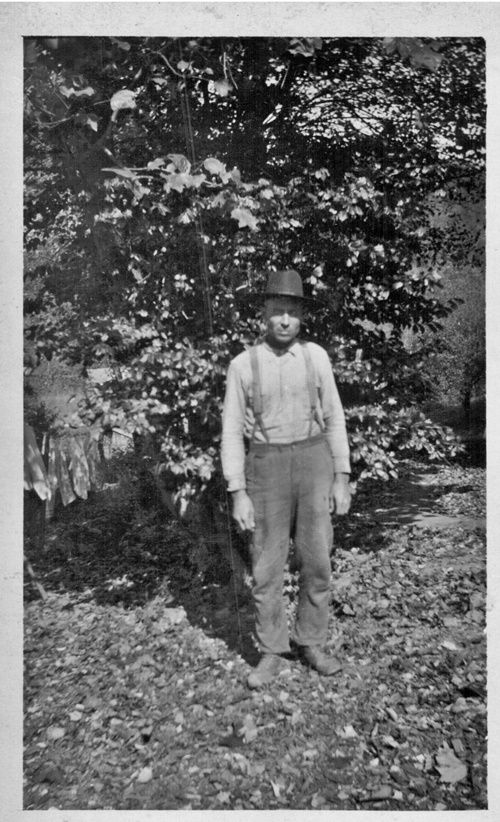
I flat-out worshiped my paternal grandfather, Joseph Hillbury Casada. Countless things endeared him. Of particular note were Grandpa Joe’s soft-spoken, folksy wisdom; magical hours spent in his company; and his unlocking doors to the natural world while teaching, by example, the joys of living close to the good earth. He died more than a half century ago, and having now reached the age where he was when we were staunch allies in all sorts of adventures, awareness has finally dawned on the blessings of what might be styled the grandfather factor.
There’s something about a skipped generation that makes a huge difference. Grandparents have decades of accumulated wisdom they can gladly share, yet they don’t have to exercise the same degree of discipline as parents. Similarly, interaction with grandchildren offers a bit of an opportunity for them to recapture their own long vanished youth. Nor should the fact that they often have ample opportunity to share that most precious of all commodities, time, be overlooked. In short, the linkage between a grandparent and the children of their children can be a thing of pure wonder.
A famous North Carolina writer, Robert Ruark, captured that magic in what are unquestionably two of the finest outdoor books ever published, The Old Man and the Boy and The Old Man’s Boy Grows Older. If you haven’t read them, a treat awaits you. Ruark lived at the other end of the state, but closer to home that bard of the High Country, John Parris, wrote dozens of columns for the Asheville Citizen-Times focusing on his grandfather. Neighboring Tennessee’s Gary Cook has given us The Old Man, and works on the timeless interaction between young boys and their grancers (traditional “mountain talk” for grand sire or grandfather) run through the literary world like sparkling diamonds of frost bedecking a winter field of broom sedge. Anyone who came of age with the benefit of loving and tolerant grandparents with whom they were able to spend a great deal of time has been truly blessed. They were privy to fonts of wisdom who tolerated much of their waywardness, shared in a fashion parents couldn’t, and served as meaningful mentors along with being true friends.
Maybe the best way to get a handle on all of this is through reflecting on my own mountain boyhood and some of the countless moments of pure joy, accompanied by the sharing of a grand accumulation of wisdom, spent with Grandpa Joe. At heart he was a boy trapped in an old man’s body, and during my formative years we shared adventures, worked hard and played harder, all the while somehow managing to squeeze an incredible amount of delight out of daily life.
Youthful days spent with Grandpa Joe served as foundational building stones for key aspects of my life. Tough as leather and strong as a well-seasoned hickory shaft, he seldom showed emotion. Yet for all his curmudgeonly exterior, he was wonderfully patient and tenderhearted with his adoring grandson. Fiercely independent, he wouldn’t labor under the supervision of another man. Yet Grandpa possessed an admirable work ethic comprised of pure grit, keen understanding of the wisdom inherent in “making do with what you’ve got,” and sharply honed skills developed during a lifetime of living in close harmony with the land. He introduced me to storytelling, provided hands-on exposure to traditional means of subsistence, and was a walking encyclopedia of mountain folkways.
While I idolized him, Grandpa was undeniably a character—at times exasperating to his wife and children, out of touch with the mainstream in every imaginable manner, and obstinate as only the most mule-headed of those of Scots-Irish descent can be. Yet with me he was seldom judgmental, never critical, and ever willing to listen to a pesky, eternally curious youngster. Highly eccentric, his idiosyncrasies only endeared him to me, and much of his perspective and general approach to life closely resembled those of a youngster.
He had no tolerance whatsoever for a goodly portion of the adult world yet was incredibly patient with me. He was distrustful of most of mankind, highly individualistic, perfectly comfortable in his own skin, religious after his own fashion, hardworking, self-sufficient, a devoted sportsman, and full of tricks as a pet ‘coon.
Thanks to him I know how to make a slingshot and select the right type of wood for the task; have solid understanding of down-to-earth subjects ranging from pulling weeds for pigs to dealing with free-range chickens; can find fishing worms; know all the tricks of catching night crawlers and spring lizards; hold an advanced education in the finer points of fishing for horneyheads and catfish; realize that formal education is by no means the only measure of a man’s intellect or his worth as a human being; am deeply permeated with traditional southern Appalachian culture; and have an abiding appreciation of the meaning of seeking oneness with the natural world. Those qualities provided me a mighty fine legacy.

In terms of physical possessions there’s little to recall the man other than the rocking chair that served as his storytelling throne now adorning my study, a single photograph of Grandpa by himself, a few grainy snapshots showing him with family members, and a push plow with which he worked his garden. That’s all and it doesn’t matter. I have a storehouse of rich memories.
Grandpa was a dreamer. In some senses he spent a lifetime dreaming, although his wanderings in the realm of wishful thinking lay outside normal approaches. Financial affairs meant little to him other than regular usage of the quaint term “cash money.” He had so little of it that the redundancy was richly deserved. He lived a life partly cast in the past and for the rest looked to the future rather than being preoccupied with the present.
Grandpa Joe never saw the ocean, but he fished pristine streams and drank sweet spring water so icy it set your teeth on edge. He never drove a car, but he handled teams of horses and understood meaningful application of the words gee, haw, and whoa. He never once ate in a restaurant, but he dined on sumptuous fare—pot likker, backbones and ribs, fried squirrel with sweet potatoes, country hams he cured from hogs he had raised and butchered, cathead biscuits with sausage gravy, cracklin’ cornbread, and other fixin’s the likes of which no high-profile chef ever prepared.
He never drank a soda, but he “sassered,” sipped, and savored pepper tea prepared from parched red pepper pods like a connoisseur of fine wines. He never tasted seafood, but he dined on fish he caught battered with stone-ground cornmeal from grain he grew fried in lard rendered from hogs he raised. He never ate papayas or pomegranates, but he grew cannonball watermelons so sweet they’d leave you sticky all over and raised muskmelons so juicy you drooled despite yourself when one was sliced. He never had crepes Suzette, but he enjoyed buckwheat pancakes made with flour milled from grain he grew, adorned with butter his wife churned, and covered with molasses made from cane he planted. He never ate eggs Benedict, but he dined daily on eggs from free-range chickens with yolks yellow as the summer sun.
In short, Grandpa Joe was not, in the grander scheme of things, an individual who garnered fame, fortune, accolades, or notable achievements. Yet he was, in my small world, the most unforgettable character I’ve ever known or will likely ever know. Sure, his life was one of limitations in many ways—geographically, technologically, economically, in breadth of vision, and at least some eyes, accomplishments. But he epitomized love, the magic of mentoring, liberal dispensation of the precious gifts of shared time and hard-earned knowledge, and down-to-earth wisdom that constitutes true common sense. Those qualities are what make the grandfather factor a thing of pure, enduring wonder.
JIM’S DOIN’S
First of all, for those of you who attended the book signing at Knoxville’s Historic Ramsey House on October 19, my apologies for not making it there. I know that my co-author for Celebrating Southern Appalachian Food, Tipper Pressley, did a great job in talking about the book along with meeting and greeting folks. Several factors entered into my absence, but all of them in one way or another revolved around the ravages of Hurricane Helene. First and foremost, the flooding shut down appreciable portions of I-40, my logical and shortest route to the site. It was already going to be a long trip, but the necessary added distance made it more than I feel comfortable in accomplishing in a single day. Then there’s the damage, direct and indirect, that Helene inflicted on me. I thought I had escaped with nothing more than three days worth of cleaning up downed limbs and some trees on my hunting property. Was I ever wrong. Apparently the motors in HVAC systems are highly sensitive to power constantly going off and back on, as was the case for me. The upshot of that is I have to replace one of the two Trane systems serving my house—and as I’ve learned to my considerable chagrin, they ain’t cheap! Add truly major damage to the home of my lady friend in Arden, NC, and worrying about her problems, and you begin to get the picture. She was actually going to accompany me to Knoxville but she had far too many problems, perhaps the most vexing of which is attempting to deal with the incredible ineptitude of FEMA (Ronald Reagan sure knew of what he spoke regarding the worst thing you ever wanted to hear being “we’re the government and we’re here to help”). I won’t get into that for the simple reason it makes my head swim and my blood boil.
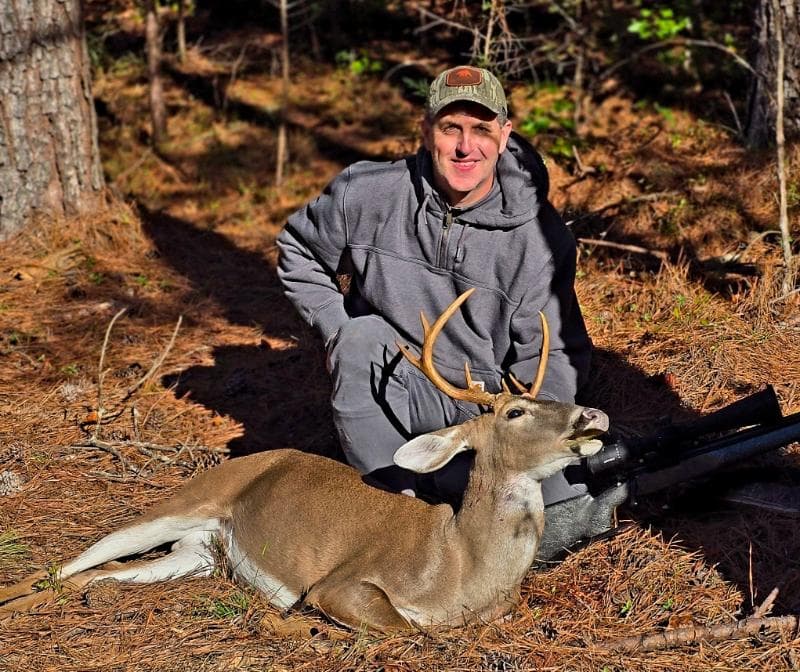
Brian Carroll with his opening day buck.
On a far cheerier note, the South Carolina Outdoor Press Association held its annual meeting in my home stomping grounds a couple of weeks back, with the Olde English Tourism District (www.oldeenglishdistrict.com) hosting the event. I’m delighted to say that our hosts did themselves proud in presenting some of the many splendors of the natural world the multi-county organization has to offer—fishing various destinations with participants enjoying considerable success with crappie and catfish, exposure to the visual beauty of the Great Falls of the Catawba River in the best way possible (from watercraft), fine fixin’s in the form of food from various restaurants and caterers in the area, and even a bit of deer hunting. Since the event coincided with opening day of the season, finding opportunities for would-be hunters was a real problem. However, I was pleased to host a couple of members on my property in Chester County, and one of them, Brian Carroll, took a nice eight-pointer with an outstanding neck shot from a prone position at close to 200 yards. At the awards banquet and auction that always wraps up the event, I was fortunate enough to have three of my entries is the highly competitive excellence in craft competition recognized. My article in Carolina Mountain Life, “The Grandfather Factor,” took first place in the magazine category and a piece for the Smoky Mountain Times, “In Praise of Pocket Knives,” place first in the newspaper section. This monthly newsletter garnered a second place in the blog competition. I’m reprinting “The Grandfather Factor” as the heart of this month’s newsletter. Those of you who have been regulars for an appreciable amount of time know how much Grandpa Joe, my paternal grandfather, meant to me. The piece that appears above is a shortened version of the lead chapter in a book now under consideration by the University of Georgia Press, “Profiles in Mountain Character.”
When it comes to writing, several of my efforts saw the published light of day in recent weeks. They include “Charles Sheldon: Visionary Sportsman,” “Sporting Classics Daily,” Oct. 3, 2024; “From the Good Earth,” Columbia Metropolitan, Oct., 2024, pp. 120-24; “The Many Virtues of Venison,” Smoky Mountain Living, Oct./Nov., 2024, pp. 14-17; and “The Wonder of Fall Wildflowers,” Carolina Mountain Life, Autumn, 2024, pp. 65-66. In addition to those pieces, my weekly column on “Mountain Musings and Memories” continues its run of almost two decades in the newspaper serving my home stomping grounds, the Smoky Mountain Times.
BOOK SPECIALS
Since hunting season is here, with the lovely Hunter’s Moon of October already come and gone, this month’s specials focus on books that deal wholly or in appreciable measure with venison. Later today I’ll be joining my buddy Darrin for a round of processing deer into burger, cube steak, and maybe some sausage. Here are offerings of books you’ll find mighty useful if you have venison of your own to enjoy (or perhaps if you want to get some useful Christmas gifts for hunters in your family or amongst your friends). Since these are reduced prices, please order directly by sending payment to me (Jim Casada, 1250 Yorkdale Drive, Rock Hill, SC 29730).
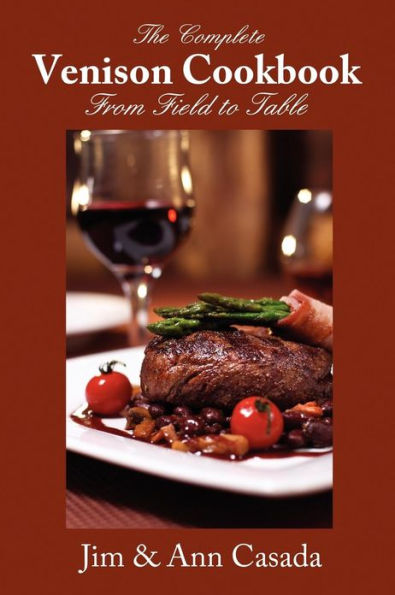
The Complete Venison Cookbook. 200+ recipes, most of them simple and straightforward. $15 postpaid.
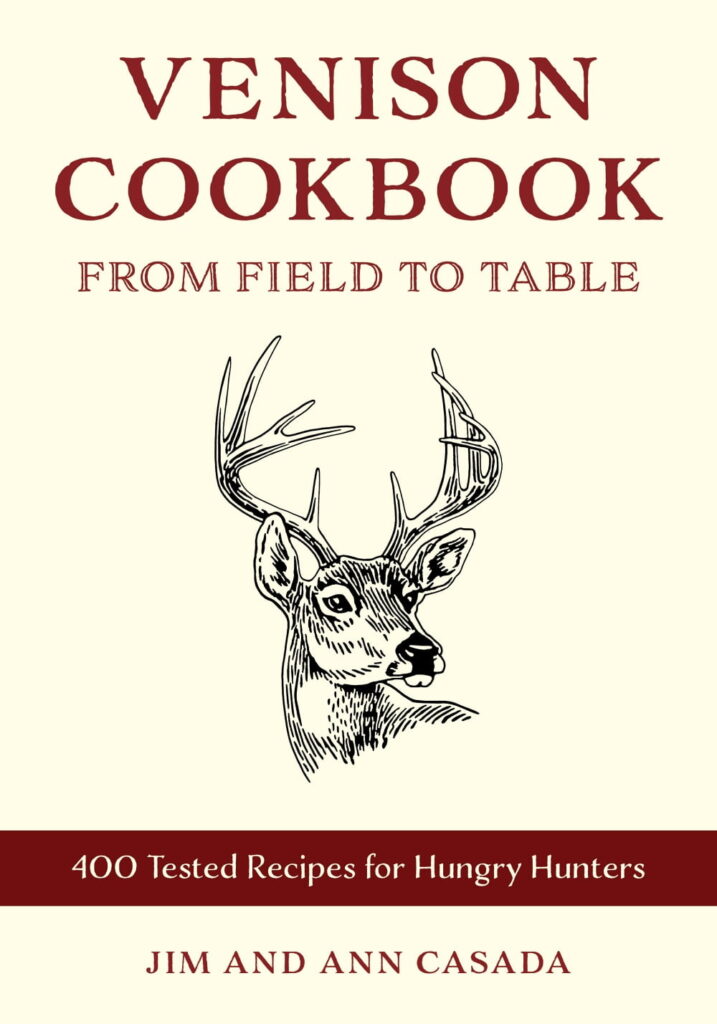
Venison Cookbook: From Field to Table. 400+ recipes. $20 postpaid.
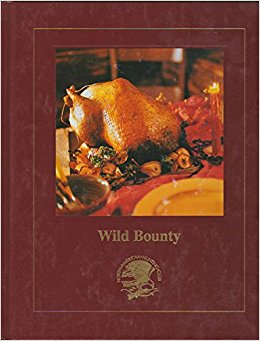
Wild Bounty. This includes a solid section on venison cookery but also covers other types of game and includes material on other foods from nature. It’s a beautifully illustrated hardback. $20 postpaid (I only have a few copies of this title).
RECIPES
One of the many things I love about October focuses on foods associated with the month. It marks a transition from the fresh garden offerings of summer to heartier fare provided by winter squash and root crops, the first opportunities to enjoy recently killed game on the table, and a time for soups and stews to soothe the inner man.
BAKED ACORN SQUASH WITH MAPLE SYRUP
½ of an acorn squash for each serving
Butter
Maple syrup (you can substitute brown sugar if you wish)
Cut acorn squash in half and remove seeds and the fiber holding the seeds. Place squash halve atop a baking sheet, open side up, and add a hefty pat of butter, along with maple syrup or brown sugar, to the cavity in the squash. Bake at 375 degrees until squash flesh is completely tender. Serve hot. Each bite (best eaten with a spoon) provides a dandy mixture of squash along with buttery sweetness.
PAN-FRIED VENISON LOIN
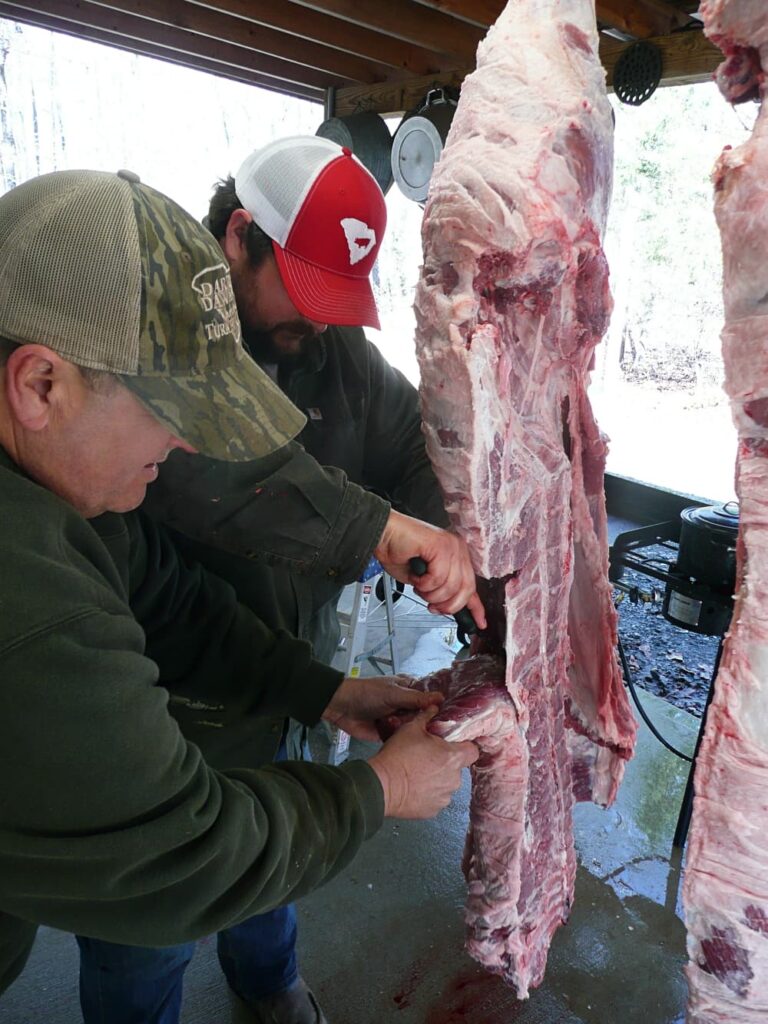
Darrin and Josh Dawkins work on cutting away the backstraps from a deer,
with another one hanging alongside and awaiting their attention.
I’m entering this recipe not two hours after a hearty breakfast featuring venison steak, eggs, and thick-sliced multi-grain bread. For the steak part of the meal, I took one of the two loins from a doe I shot, thoroughly pounded it with a meat hammer until it was flat as a flitter, coated both sides with flour, added salt and pepper, and fried it quickly in hot bacon grease. I took it from the skillet when the meat was still pink inside the pounded loin. (I should note that loins are the small pieces of wonderful steak on the underside of a deer’s rib case while the much larger backstraps rest exactly where the word implies—along the backbone atop the rib cage). Partnered with traditional breakfast foods, it makes a wonderfully hearty and tasty breakfast. You’ll have to provide the deer loin, but once you have that critical ingredient the rest is the essence of simplicity and a fine way to celebrate a successful hunt while the rest of your deer is hanging in a cooler to age prior to processing.
PUMPKIN PIE
From my earliest memories this traditional mountain version of pumpkin pie was a fixture on the menu at Thanksgiving and Christmas along with being offered several other times in late fall and winter. We raise our own pumpkins and they would keep, stored in our equivalent of a root cellar (a dirt-walled basement), for many months. This recipe appears in the cookbook Tipper Pressley and I wrote, Celebrating Southern Appalachian Cooking, and if you would like to see a video of its preparation by Tipper, you can do so by viewing her YouTube vlog and see the pie in the making (and eating!).
1 cup brown sugar
1 teaspoon ginger
1 teaspoon cinnamon
¼ teaspoon salt
1 cup stewed pumpkin
2 eggs, lightly beaten
2 cups milk
2 tablespoons melted butter
Pastry
Add the brown sugar and seasonings to the pumpkin and mix well. Then add the lightly beaten eggs and milk. Finally, stir in the melted butter. Turn the pie mixture into a pie plate line with pastry and bake at 425 degrees for five minutes. Then lower the heat to 350 degrees and bake until the filling is set. Allow the pie to cool prior to slicing and serving..
NOTE: You can substitute the flesh of cushaws or candy roasters for pumpkin.
PERSIMMON PUDDING
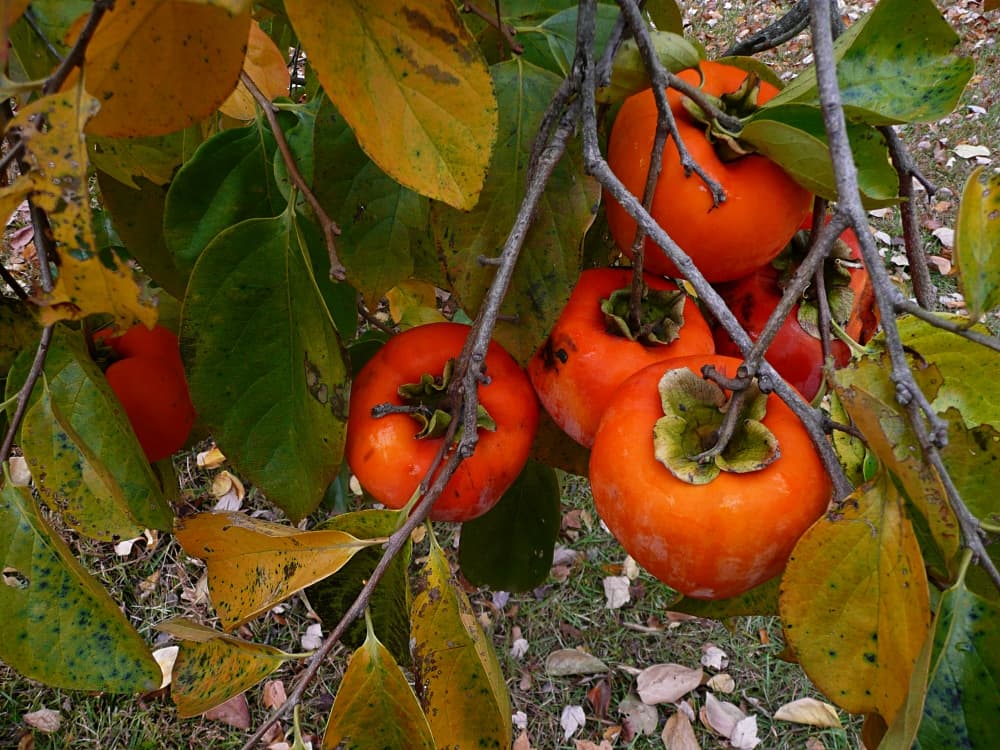
These chunky Oriental persimmons make dishes featuring “nature’s candy” comparatively easy to prepare.
I’ve always had a sweet tooth, and my interest in foods from nature has also been a prominent feature of my interests throughout life. This recipe combines what hunters sometimes describe as “nature’s candy” in the form of sticky sweet ripe persimmons with readily available kitchen ingredients to make a wonderful, and wonderfully rich, dessert. I must confess that these days, thanks to my yard being home to two fine, heavy-bearing Oriental persimmons, I make things considerable easier with these big, seedless cousins of our wild persimmon. I can’t tell any difference in the taste and the work load is reduced a great deal.
2 cups persimmon pulp
2 cups brown sugar, packed
¼ cup butter, melted
1 teaspoon vanilla
1 ½ cups self-rising flour
½ cup light cream or whole milk
2 eggs, beaten
½ teaspoon cinnamon
½ cup raisins or black walnuts (optional)
Combine all ingredients and beat until well mixed. Pour into a 9” x 13” pan and bake at 350 degrees for 30 to 35 minutes or until golden brown and just beginning to pull away from the sides. Remove from oven and cool slightly before cutting into squares. Serve with whipped cream or hard sauce.
NOTE: This is a very rich dish and portions should be small.
TURNIPS AND GREENS
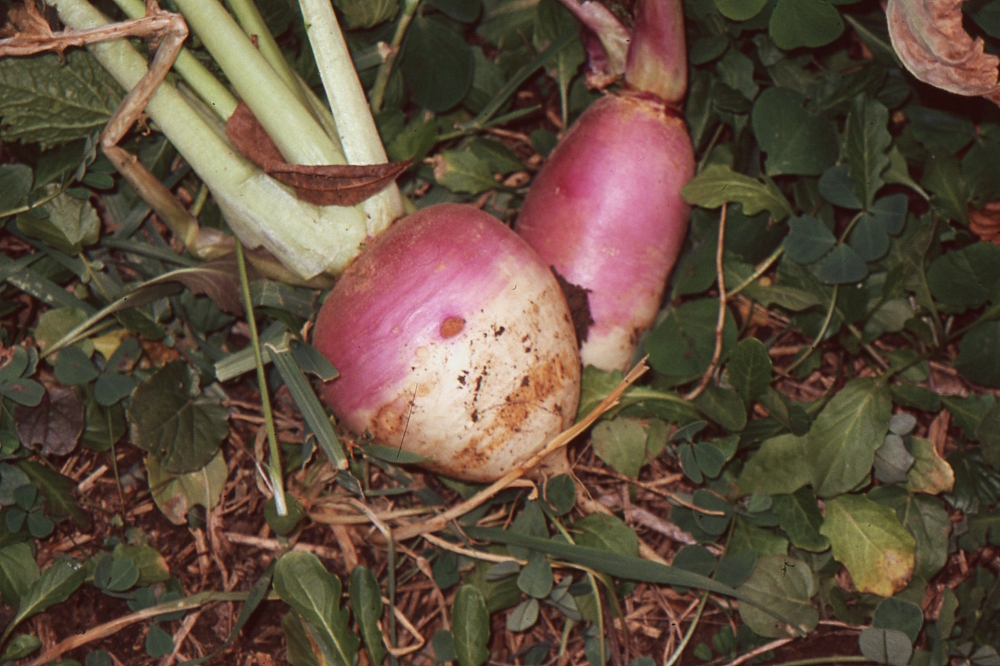
Cleaned and stewed with greens and some streaked meat, turnips make mighty fine eating.
To my considerable delight, my hunting buddies, keepers of the whitetail culture, unofficial land managers, and the kind of friends anyone is blessed to have, Darrin Dawkins and his son Josh, did a wonderful job of getting in food plots on land I hired a heavy equipment operator to clear back in late summer. The result was some dandy food plots, and timely rains saw the mixture of oats, winter wheat, sunflowers, and mustard up and growing beautifully by mid-September. The primary purpose of these plots is obviously to serve as an attractant/food source for deer and wild turkeys, but later in the fall I’ll enjoy some fringe benefits from the turnips. I’ll pluck a number of the purple-topped globes from the soil, pick a big mess of turnip greens to go with them, and join the deer for a feast of my own. I love turnip (or mustard) greens cooked with small cubes of stewed turnip roots, and the dish is a hearty one that takes me straight back to Momma’s stove where she always fried two or three pieces of fatback to season the turnips-and-greens mixture. Here’s a close approximation of how she prepared a dish that appeared regularly on our cool and cold weather family menu.
1 peck of loose greens
3 medium-sized turnips
2 or 3 slices of fatback (streaked meat)
Salt and pepper to taste
Wash a big bait of greens, rinsing and draining at least three times to be sure you’ve removed all grit. If the leaves are quite large, remove the stems. Chop up the turnips into small pieces and place the greens and turnips in a large stew pot with plenty of water. Throw in the streaked meat (you can pre-fry and include the grease or just add the uncooked fatback straight to the pot) and bring to a boil. Then reduce to a simmer and cook until the greens and turnips are done. Season with salt and black pepper to taste and serve piping hot. This dish goes mighty well with a chunk of cornbread.
FRESH APPLE CAKE
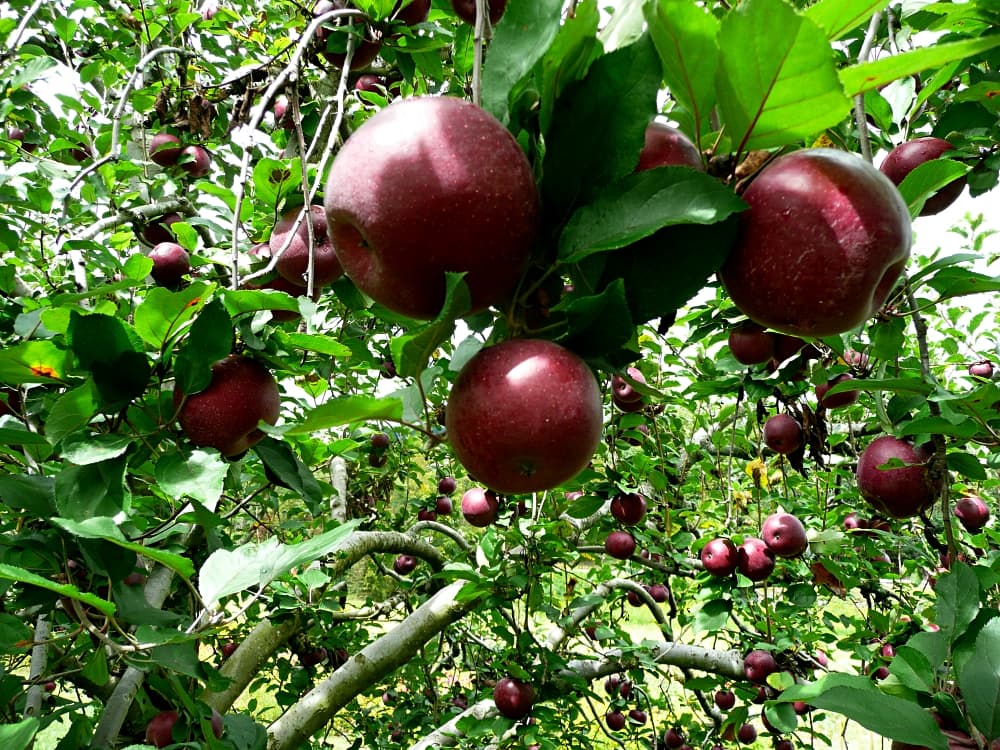
Although these apples are a variety we did not raise,
they hang heavy as Daddy’s trees almost always did.
My father maintained a small apple orchard with meticulous care that included careful pruning each year, multiple sprayings, keeping the ground clean and clear beneath the trees, and general attention to any and all details connected with producing fine fruit year after year. As a result, come autumn we enjoyed rich bounty in the form of bushels of Golden Delicious, Red Delicious, and Stayman apples. Momma used them in many ways—dried for fried pies or to share with Grandma Minnie to use in apple stack cakes, canned in quart jars for what we called apple sauce (it was actually more like stewed apples) that was a standard feature of most meals for months to come, and in all sorts of scrumptious desserts. This one ranked well towards the top of my long list of favorite sweets.
CAKE
4 eggs
3 cups sugar
3 cups self-rising flour
1 cup raisins
1 cup cooking oil
3 cups diced apples
1 cup black walnuts
2 teaspoons vanilla
Beat the eggs and then add remaining ingredients. Batter will be stiff. Bake in a 9” x 13” cake pan for an hour at 350 degrees.
FROSTING
1 (13 ounce) package cream cheese
¼ cup butter
2 cups powdered sugar
1 teaspoon vanilla
Blend with a mixer, a pulser, or by hand. Apply to the cake after it has cooled.